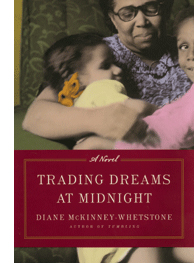Mothers and daughters tangle and untangle in West Philadelphia.

TRADING DREAMS AT MIDNIGHT: A Novel
Diane McKinney-Whetstone CW’75, faculty.
Harper, 2008. $24.95.
From Homer to Amy Tan, the multi-generational family saga is a time-tested vessel for the exploration of individual personalities. For every noble son, there’s another who steals his rival’s wife, and for every daughter who takes after her powerhouse mom, there’s another who’s inexplicably meek. Whatever their setting, and whatever their arc, the best of these stories wrestle with the questions of inheritance and the peculiar ways in which we differ from our kin.
In her fifth novel, Trading Dreams at Midnight, Diane McKinney-Whetstone (a lecturer in the Center for Programs in Contemporary Writing) brings the family saga home. Something of an artistic ethnographer, McKinney-Whetstone has done for Philadelphia what August Wilson did for Pittsburgh, mapping the ups and downs of the city’s African-American community from the 1940s to the present.
Trading Dreams’ matriarch is Nan, a tough, churchgoing seamstress who comes to Philadelphia from Georgia in 1947. Her charismatic daughter Freeda has two daughters—headstrong Neena and sensitive, rule-following Tish—by different fathers. Prone to psychotic breaks, Freeda often leaves the girls with their grandmother, and one night in 1984, she disappears for good.
In the aftermath, 11-year-old Tish allows Nan to become the mother Freeda never was. She takes comfort in church and excels in school, eventually becoming an anchor at a local TV station. But 15-year-old Neena has a harder time, vowing to find her mother and quarreling constantly with the often-tyrannical Nan. As an adult, she makes her living dating rich married men and extorting them for cash. Like her mother before her, she becomes estranged from her family, until, on the 20th anniversary of Freeda’s disappearance, she returns penniless to her hometown, where the well-married Tish is struggling to hold on to a complicated pregnancy.
The novel alternates between February 2004 and extended flashback, as Nan and prodigal granddaughter Neena ruminate on the sorrows of the past. From the first page, McKinney-Whetstone writes in a syntactically halting, almost incantatory style that befits the title’s reverie, even as it veers toward melodrama. Consider her second sentence: “A hot pink raw silk Freeda was when she was a happy girl, spreading herself out into a mesmerizing display with her thunderstorm hair and butter brown lips until her sadness hit and she’d scrunch herself up into a tight bland button and then poof, she was gone.”
Though there’s occasionally more perspiration than inspiration in McKinney-Whetstone’s prose, the book is nonetheless absorbing, particularly in scenes that highlight the city. From the corner shops in West Philly to the street musicians on South Broad, McKinney-Whetstone’s Philadelphia is vibrant, lovingly rendered, and thoroughly recognizable.
Even more recognizable are the characters, who share DNA, a hometown, and a searing sense of abandonment, but have nonetheless become very different women. Here, McKinney-Whetstone admirably sheds light on the gray area between nature and nurture—the arbitrariness of mental illness and the enduring mystery of the self.
—Katherine Hill




